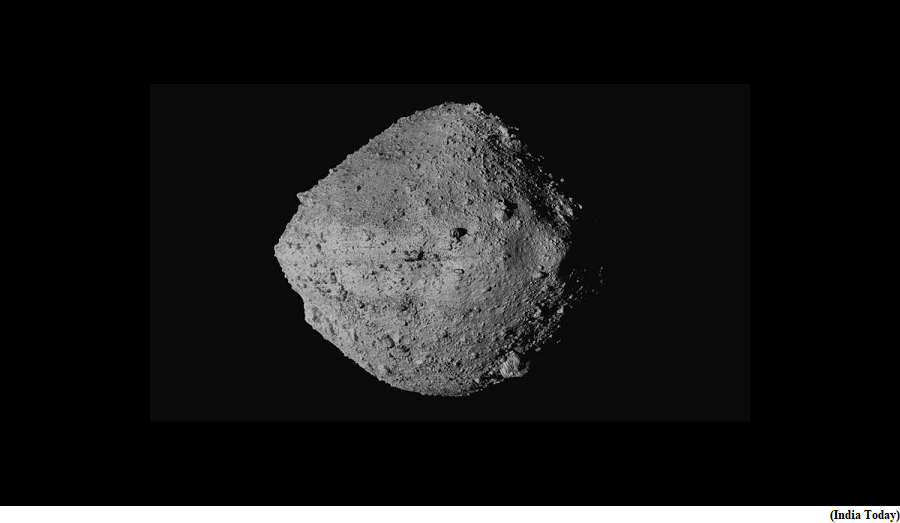Soil from asteroid that could swallow a spacecraft to fly down to Earth (GS Paper 3, Science and Tech)

Why in news?
- Three years after it grabbed a sample of rock and soil from an asteroid floating in the vacuum of space, the Osiris-ReX mission is ready to drop it to Earth.
Details:
- The spacecraft will drop its sample under a parachute on September 24, 2023 making the US the second country to return samples from the surface of an asteroid after Japan.
- The samples will be dropped into the Utah desert, bringing the seven-year-long mission to a close as Osiris ReX continues on in space to its next target asteroid.
- The spacecraft, dubbed Origins, Spectral Interpretation, Resource Identification, Security-Regolith Explorer or Osiris-ReX, is returning samples from asteroid Bennu, a Near Earth Object (NEO).
What is Asteroid Bennu?
- The asteroid was discovered in 1999 by the Lincoln Near-Earth Asteroid Research (opens in new tab) (LINEAR) telescope in New Mexico and is named after the heron God Bennu from Egyptian Mythology.
- Asteroids are the ancient materials left over from the original era of planet formation and may contain molecular precursors to life.
- It added that scientists have learned a great deal from studying asteroid fragments that have naturally reached the ground as meteorites.
- But to understand whether asteroids played a role in delivering these compounds to Earth’s surface over 4 billion years ago, scientists need a pristine sample from space, free from terrestrial contaminants.
Background:
- The spacecraft was launched in 2016 from the US on a two-year-long mission to its destination, Bennu. The spacecraft got its first view of the asteroid in August 2018 when it pictured a grainy object from a distance of 2.3 million kilometers.
- After arriving at Bennu in 2018, the spacecraft mapped the asteroid, scouting for a spot to pick up the sample among the extremely rocky surface with hazardous boulders.
- A year later, the mission team selected a site called Nightingale in a northern crater 460 feet wide on the surface to lift the samples.
- The spacecraft On October 20, 2020, opened its robotic arm to perform a Tag maneuver (touch and go) as it briefly touched down on asteroid Bennu to collect dust and pebbles from its surface.
Way Forward:
- After releasing the sample, the spacecraft will not stop and will power on to its next target - asteroid Apophis.
Strongest eruption from Sun in three years slams Earth
(GS Paper 3, Science and Tech)
Why in news?
- A geomagnetic storm hit Earth recently and the impact has been ongoing, as auroras are expected to be triggered on higher latitudes of the planet.
- The geomagnetic storm has been triggered by a massive explosion from a large coronal hole in the southern hemisphere of the Sun.
- The severe geomagnetic storm was escalated from G3 to the G4 category by the US-based Space Weather Prediction Center under the National Oceanic and Atmospheric Administration (NOAA).

What are Geomagnetic storms?
- Geomagnetic storms are a major disturbance of Earth's magnetosphere that occurs when there is a very efficient exchange of energy from the solar wind into the space environment surrounding Earth.
- These storms result from variations in the solar wind that produce major changes in the currents, plasmas, and fields in Earth’s magnetosphere.
What happened at the Sun?
- The geomagnetic storm was a result of Coronal Mass Ejections (CMEs) that ejected billions of tons of material and plasma from the sun toward the planets at speeds of millions of kilometers per hour. The current set of ejections was from a coronal hole on the surface of the Sun.
- Recently, plasma exploded high above the sun's surface, going as high as the height of 14 Earths stacked together.
- Solar physicists had not expected that the storm from the Sun would be so extreme when it hits Earth that it will create the strongest geomagnetic storm in over three years.
Why is the Sun so active?
- The Sun at the moment is going through its 11-year-long cycle, which affects activity on the star.
- With the solar maximum approaching, the sun is ramping up activity, which will begin to go down once it reaches its peak.
- Every 11 years, the Sun's magnetic field flips, marking the end of the cycle.
- At the moment there are nine sunspots on the surface of the sun, however, all of them are quiet and stable for now.
Aditya L-1:
- India is set to launch its maiden solar mission Aditya L-1 in 2023, which will further improve India's forecasting of space weather and conditions on the Sun.
- The spacecraft will unravel the Sun's coronal magnetometry as the energy needed for the dangerous Coronal Mass Ejections (CME) from the Sun emerges from the magnetic field in the corona.



